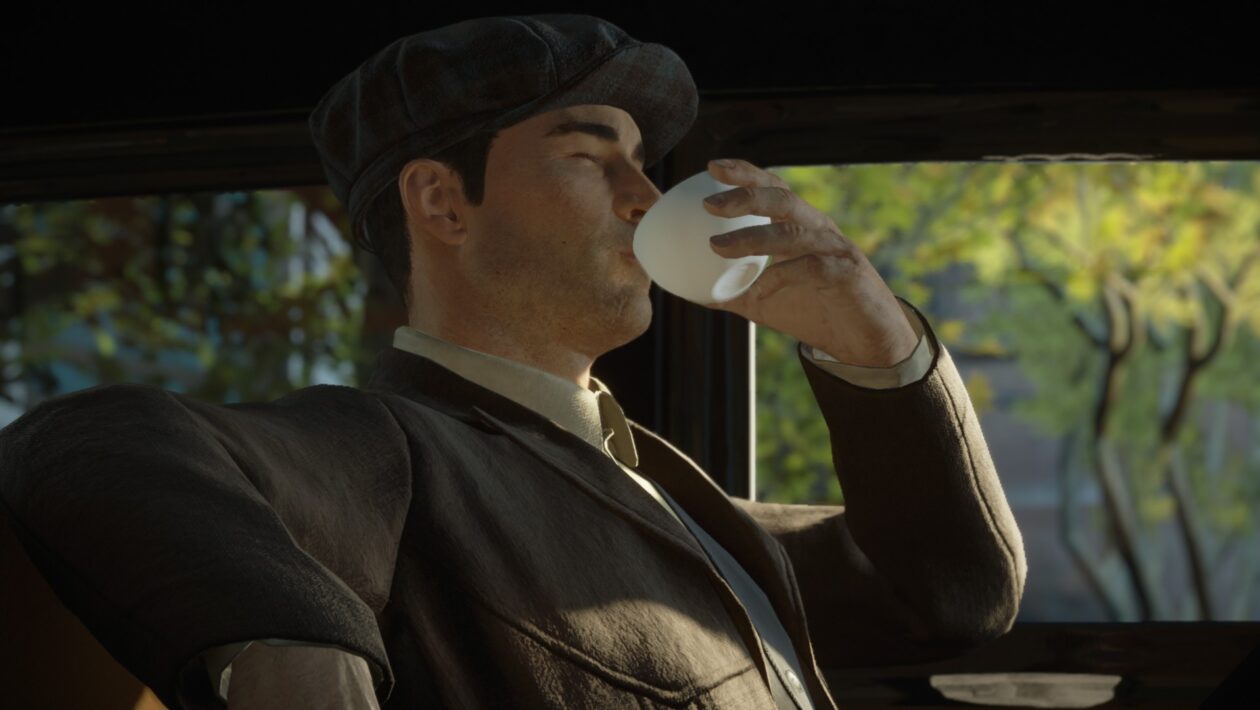Review of Empire of Sin »Vortex
Like setting up a secret bar but not ordering a good whiskey. Like when you go pick up the fire and leave with five dollars and a baseball bat that’s not even a little out of blood. Like when you drive a vendetta, but in the end only your own grandmother dies of a covid. This is roughly the Empire-Sin construction and tactical strategy, thematically set in the 1920s and the Prohibition era in the United States, promising an attractive war between mob families for dominance over Chicago and its dark alleys, bars, hotels and brothels. As a great idea, hardly an average implementation and an unconvincing result. As a game you were looking forward to, they wanted to give it a chance and were willing to forgive cosmetic shortcomings, but in the end you don’t feel like repeating it.
Empire of Sin is characterized by openness. A player in the shoes of one of the wanabee mob bosses enters the campaign with a simple assignment: make sure Chicago belongs only to you. The game generates a defined number of city districts, deploys opponents bases and presses an imaginary starting pistol. And now, dear Capons, show what we are dormant in you… The path to subjugation of the game world leads through a combination of economic and tactical part. An equally important part is the occupation of buildings and the improvement of business in the area of distilleries, infusions, hotels, etc., as well as shootings and fights in the streets and interiors, solved in the spirit of X-COM as a tactical tactical interlude. The player thus gradually expands his empire, hires and equips gangsters better and better, and leads diplomacy and open war with other factions until they get on the grasshopper or lie on the mattresses himself.
Contents
Frank Ragen gives a homerun
The first impression of the Empire of Sin is definitely great. Individual bosses have their personalities, typical visage and favorite weapons. The game nicely draws dirty streets and gives a specific character to different neighborhoods. For a global view, you can zoom out on the map stylized as a clear board. An enticing theme, important props (such as Tommy Gun, who swings your newly hired warrior next to a purse on a flowered dress), partial tasks tied to individual characters and the apparent depth of the economic part suggest a long-lasting and “full-fat” gaming experience. And if I were bound by omerta, the review could end here. But you know what, before I take a closer look at the main sawmill, I’ll tell you something else.
The art of counting
Apart from tactical fights, the game is bothered by repetitiveness. The player occupies the buildings and enlarges his empire. It revolves around two commodities – money and alcohol. Thus, it is necessary to balance the production of beer and its consumption in bars and brothels. At the same time have a basis of income from guests of various economic levels, so that there is something to pay for voracious gangsters. The whole model is largely unbalanced. Example: buildings can be improved in several ways – so that, for example, the bar is more attractive, better defended against enemy takeovers, better hidden from the police. These upgrades are relatively expensive and only pay for in a very long time; the game time flows at one pace and can only be stopped, but not accelerated. After a few hours of rehearsals, I completely resigned myself to any improvements, left the buildings at the basic level and, godfather, wonder – nothing happened and I finished the game without difficulty.
Brenda Romero: Designer Wizardry and Playboy: The Mansion
The main designer of the Empire of Sin is Brenda Romero (54), the wife of the more famous John Romero. Still under the original name Brenda Brathwaite, she worked at Sir-Tech and participated in the development of the RPG series Wizardry (first as a tester, in the eighth part as a designer), Jagged Alliance and Realms of Arkania. This was followed by employment at Atari and the development of the console series Dungeons & Dragons, and work for Cyberlore Studios on Playboy: The Mansion. Later, Brenda Romero also published the book Sex in Video Games. He also has a solid academic career.
The hotel bonuses are just as futile as the improvements themselves: in each neighborhood, the hotel brings in extra money in connection with the entertainment that guests can experience, and the more the more interconnected “trades” the player offers. At the same time, they are organized into poker combinations such as a three, a full house, etc. As a result, however, it is just an extra screen that the player can cheerfully ignore. And a third example for all: weapons and various equipment can be bought on the black market. But if a package of dynamite or a bottle of syrup costs more than equipping and renovating a restaurant, you have to shake your head. Being a “painter of rooms” probably really paid off for the prohibition…
Broken missions
The tasks partially save the player from boredom and tedious repetition of the same actions. There are quite a few of them, they are related to the development of their own mafia empire, the individual characters and their stories, as well as the neutral factions that operate in Chicago. Fulfilling missions is sometimes fun, but sins are also often technically broken. When the game does not allow you to find the entering character. When suddenly the indicators for all but one mission turn off. When a gangster is to return to play after a serious injury after two months, but only lies on the ground with minimal health and does not react. When the game not only crashes, it also causes the system to stop recognizing the connected keyboard (wow, how did you do THIS, Mrs. Romero?). It wasn’t until the third campaign that started that, by chance, it worked as it should, from start to finish, and the feedback from the players confirms that I was unlucky, but met with a harsh reality.
But what about duels? Can they save a battered face? Unfortunately, except in its strongest moments. There is basically not much wrong with the system itself. The characters move across a square field, using visibility, range of various weapons, half and full cover. Different classes of gangsters develop different skills and can then heal, effectively kill at close range, or crush their opponents from a great distance with a sniper rifle. But there are three problems: map design, imbalance and repetition.
Security of blasting
The vast majority of battles that players wage will take place in similar and little imaginative scenery. There are few designs of individual types of buildings and they offer insufficient space for tactics. Combined with a weaker artificial intelligence, which does not like to take the opportunity to flood the player and on the contrary, it is foolishly approaching, this is a consideration. Repeated “clearing” of neutral gangsters in small warehouses is perhaps more annoying than cleaning windows before Christmas. Fights in the open space of the streets, in which the guards are happy to join, but which takes three moves before they get within range of the enemy, then they have a rush to wash dishes or clean the room.
Finally, players are constantly destroyed by an imbalance between different types of characters and weapons. A sniper rifle is an insta-kill tool, and if your opponent has a soldier with a sniper rifle, you just grind anger between your teeth. Often a meaningless percentage of hits, when the character is standing directly in front of the enemy or for two steps and the exaggerated effect of some close strokes (and I understand that a boxer or a baseball bat is something other than a bare fist) then complete the work of destruction.
Godfather-fight as a reward
Of course, the Empire of Sin also has strong moments. These include the major battles for an important building or base of an enemy gang. Then the opponent puts his best soldiers into play with the boss in action, and a well-equipped group is challenged to win such a battle. Then there is finally the use of additional equipment, mutual coverage of characters, traps for enemies and healing. However, success means that not only the base, but the entire realm of the defeated boss will become part of the player’s empire. Which, unfortunately, defines the most effective way to victory, which does not lead to slow development and building while experiencing the personal stories of the characters. No way. Take the first few buildings to get the economy going, hire the team and the bones of one boss after another. Benefits? You will avoid a million unnecessary fights, where three desperate people from one clan attack the player’s bar defended by his two desperate people, and while the player also becomes desperate and clicks out moves that cannot change the result, tempus fugit…

Mob Rule (Street Wars): Gang Wars in retro strategy from the nineties
The game from history, to which Empire of Sin is closest in genre, is Mob Rule (also Street Wars: Constructor Underworld or Constructor 2). In isometric graphics, players built factories, brothels, hotels, and even cemeteries, and used the services of workers, repairmen and gangsters. In addition to murders and kidnappings, they also performed more sophisticated malicious activities, such as spreading cockroaches around their opponents’ houses. The 1999 game is available for $ 5 on GOG.
When patches and long-term testing fix game crashes and the most serious bugs, Empire of Sin will be a decent, slightly above-average strategy with great styling and a few interesting ideas. At present, unfortunately, this game is not only unfinished, but also broken.
Mrs. Romero? Mr Salieri greets you…



